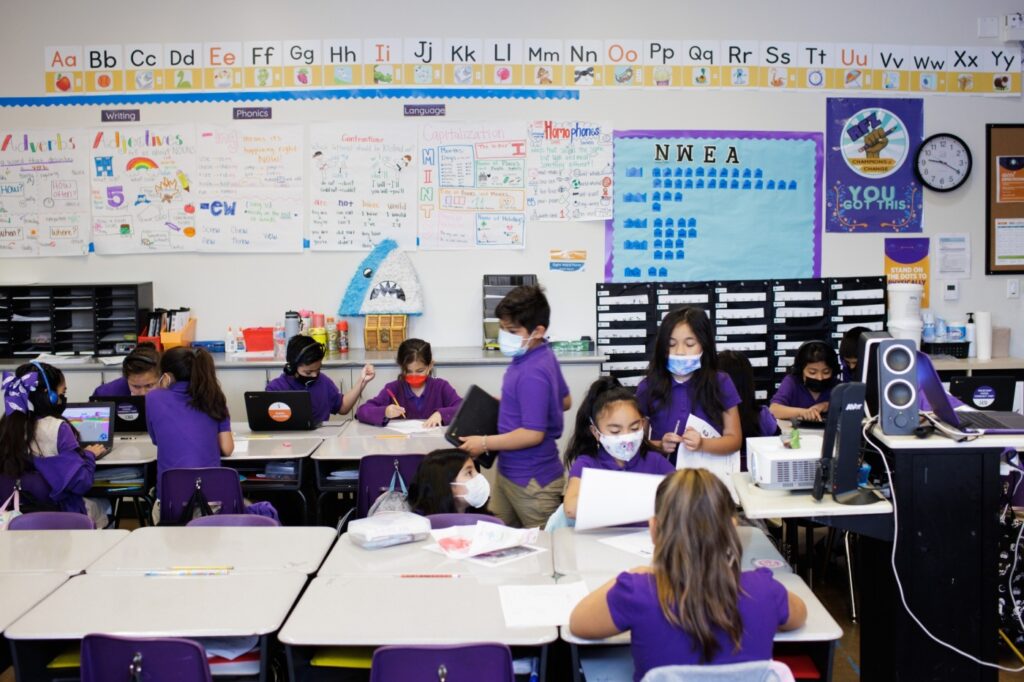
The second school year under COVID restrictions saw another big drop in the number of students in California public schools, dipping below 6 million for the first time in more than 20 years, new figures released Monday show.
The state Department of Education’s new 2021-2022 school year data shows student enrollment dropped by 110,000 students, a 1.8% dip from last year, but less than the 161,000 decrease the year before.
Enrollment had been steadily declining in the state’s public school system before the COVID-19 pandemic due to skyrocketing living costs, declining birth rates and migration patterns, a Bay Area News Group analysis found. But the drop accelerated in the last two years when parents grew frustrated with distance learning. Many of them stuck with the new options they turned to while classes were online.
And in a dramatic turn, charter school enrollment fell 1.8% statewide last year. Enrollment in the independently operated public schools had been on the rise for years, and now account for nearly 12% of all public school students. Large urban districts across the state account for close to one-third of the drop in the current year, according to the California Department of Education. In contrast, private school enrollment rose 1.7% in the last year.
The department of education blames “COVID-19 disruptions for a large part in negating the steady enrollment gains over the last decade.” While it is true that enrollment started to rebound after the Great Recession of 2007-09, enrollment never fully recovered to earlier levels and began to decline in 2017.
A closer look into the data shows the biggest percentage drops were among Pacific Islander students followed by White, Black, Asian, and Latino students. Students identified as two or more races increased by 1.7 percent and a number of students that did not report their race increased by 18.3 percent, the data shows.
Trends revealed in the new data show that the largest grade-level decreases were in 1st, 4th, 7th and 9th grade classrooms. Enrollment increases from the prior year occurred in kindergarten and 12th grade. English learners had a boost with more than 6% growth in enrollment from last year.
That is a change from last year, when the largest decline in enrollment happened in kindergarten and sixth grades.
The bump in the number of kindergarten students could signal a change of heart among parents who worried about enrolling their young ones in virtual classes for their first year of school — when hands-on interactions are so important. Many parents chose to keep them home, or sent them to private schools that taught classes in person, said Julien Lafortune, a research fellow at the Public Policy Institute of California, about last year’s decline.
The new data also shows lower enrollment among vulnerable children. There was more than 6% drop in homeless students, a 4% drop in foster youth, a 3% drop in socioeconomically disadvantaged students and a half of a percent drop in students with disabilities. It’s unclear whether the drop in homeless students is because students found a more stable living environment, Cindy Kazanis, a director of the CDE’s analysis, measurement and accountability reporting division, said.
While enrollment is declining, chronic absenteeism, especially in large urban districts, is increasing. That’s a problem for schools who need more funding to offset drops in attendance — which is how the state reimburses districts. School districts won’t experience a decline in funding due to decreases in attendance this year, under state law enacted during the pandemic, but school leaders could face repercussions when relief ends next year.
The lean budgets are leading school boards to trim costs by closing schools, laying off teachers and cutting school programming – and state legislators and lawmakers are scrambling to help.
To help schools, the state department of education has supported districts with outreach to families of chronically absent students. The state is giving special attention to boost transitional kindergarten enrollment and to help schools to “meet the needs of families around transition years,” and to offer options and pathways to keep high school students connected, their news release reads.
As a result of the rapid declines, the department of education and state Superintendent Tony Thurmond are supporting Senate Bill 830 authored by Democratic state Sen. Anthony Portantino to change school base funding from attendance to enrollment.
Supporters of the legislation say the change could help equitably fund schools while helping districts that struggle with absenteeism[. Critics argue the new funding formula could disincentive schools’ from combating chronic absenteeism, among other concerns.
California isn’t the only public school system with steep declines. Chicago and New York are also experiencing dramatic dips, according to the CDE.
“We’ve been looking nationally at trends across the country in public education, and we’ve been noting that there’s a dip in enrollment sort of across the board,” said Maria Clayton, a spokeswoman for the department of education.
